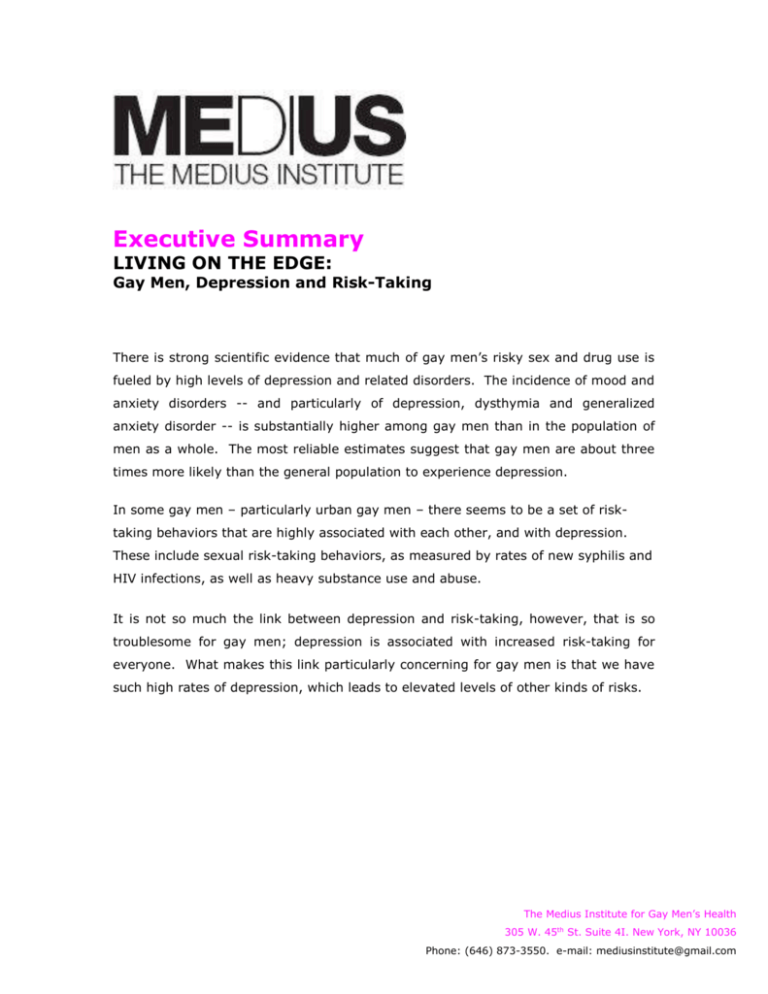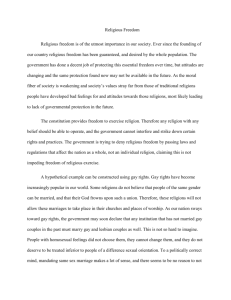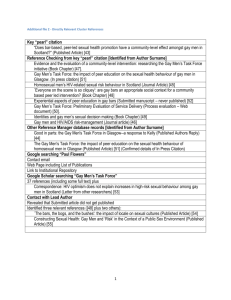
Executive Summary
LIVING ON THE EDGE:
Gay Men, Depression and Risk-Taking
There is strong scientific evidence that much of gay men’s risky sex and drug use is
fueled by high levels of depression and related disorders. The incidence of mood and
anxiety disorders -- and particularly of depression, dysthymia and generalized
anxiety disorder -- is substantially higher among gay men than in the population of
men as a whole. The most reliable estimates suggest that gay men are about three
times more likely than the general population to experience depression.
In some gay men – particularly urban gay men – there seems to be a set of risktaking behaviors that are highly associated with each other, and with depression.
These include sexual risk-taking behaviors, as measured by rates of new syphilis and
HIV infections, as well as heavy substance use and abuse.
It is not so much the link between depression and risk-taking, however, that is so
troublesome for gay men; depression is associated with increased risk-taking for
everyone. What makes this link particularly concerning for gay men is that we have
such high rates of depression, which leads to elevated levels of other kinds of risks.
The Medius Institute for Gay Men’s Health
305 W. 45th St. Suite 4I. New York, NY 10036
Phone: (646) 873-3550. e-mail: mediusinstitute@gmail.com
Substance use and associated risky behaviors are generally highly correlated with
depression.1 More than 50 percent of urban gay men report use of recreational
drugs in the past six months. 2 Almost 20 percent say they are “frequent” users of
powder drugs, including amphetamines, ketamine, and cocaine. 3
Depression and related disorders, such as dysthymia and generalized anxiety
disorder, are also strongly associated with gay men’s sexual risk-taking.4 However,
this association between depression and sexual risk is complex, and affected by a
number of important contextual factors, including HIV status of self and of partner,
sexual activity and role, relationship to sexual partner, and venue of sexual
encounter. 5,6
The frequency of major depressive disorders was nearly twice as high in HIV-positive
subjects as in HIV-negative people.7 Depression has been associated with increased
likelihood of unprotected intercourse in HIV-infected people8 and particularly in those
with demonstrated antiretroviral drug resistance. 9 However, appropriate treatment
of depression in HIV-positive people is the exception rather than the norm. 10
Office of Applied Studies. (2005). Results from the 2004 National Survey on Drug
Use and Health: National findings (DHHS Publication No. SMA 05-4062, NSDUH
Series H-28). Rockville, MD: Substance Abuse and Mental Health Services
Administration.
2
Stall R, Paul JP et al. Alcohol Use, Drug Use and Alcohol-related Problems Among
Men Who Have Sex With Men: The Urban Men’s Health Study. Addiction. 96(11). Nov
2001. p. 1589
3
Stall 2001. Ibid.
4
Koblin BA, Husnick MJ et al. Risk factors for HIV infection Among Men Who Have
Sex With Men. AIDS. 2006 Mar 21;20(5):731-739.
5
Martin JI & Knox J. Loneliness and Sexual Risk Behavior in Gay Men. Psychol Rep.
1997 Dec; 81(3 Pt 1): 815-25
6
Parsons JT, Halkitis PH et al. Correlates of Sexual Risk Behavior Among HIV-Positive
Men Who Have Sex With Men. AIDS Educ Prev. 2003 Oct;15(5):383-400
7
Ciesla JA, Roberts JE. Meta-analysis of the Relationship Between HIV Infection and
Risk for Depressive Disorders. Am J Psychiatry. 2001 May;158(5):725-30.
8
Parsons. Ibid.
9
Chin-Hong PV, Deeks SG et al. High-risk Sexual Behavior in Adults with
Genotypically Proven Antiretroviral-resistant HIV Infection. J Acquir Immune Defic
Syndr. 2005 Dec 1;40(4):463-71.
10
Vitiello B, Burnam MA et al. Use of Psychotropic Medications Among HIV-infected
Patients in the United States. Am J Psychiatry. 2003 Mar;160(3):547-54.
1
ii
Although the links among drug use, sexual risk and depression are strong, it would
be an oversimplification to say that depression “causes” the risky behavior. Instead
it appears that in gay men, multiple epidemics -- such as depression, drug abuse,
violence, childhood sexual abuse and HIV -- interact to increase risk for one another:
depressed people, for example, are more likely to abuse recreational drugs; drug use
contributes to depression and increases rates of behavior that puts the user at risk
for HIV; gay men with HIV are more likely both to be depressed and to use drugs.
Dr. Ron Stall coined the term “syndemic” to describe these overlapping, mutually
reinforcing epidemics.
The interactions among these epidemics have potentially important implications for
health promotion programs targeting gay men. More effective programs will need to
address other contributing concerns, such as depression, and may include
components that address a range of interacting health concerns rather than focusing
exclusively on single-issue problems. Furthermore, efforts to address “root cause”
issues, such as loneliness, may for gay men be the most effective ways to prevent
HIV and substance abuse.
For gay men, though, depression and related psychosocial problems seem to play a
central role in health, similar to that of obesity in the general population. Just as
overweight people have increased risks of cardiovascular disease, diabetes and other
serious illnesses, gay men with depressive disorders are at substantially increased
risk for a variety of other negative health outcomes, including alcoholism, drug
addiction, and HIV infection.
iii
Summary of Recommendations
Gay men need increased access to comprehensive mental health services.
Mental health diagnostics and services should be integrated into general
medical care for gay men and fully reimbursed by insurers.
Access to mental health specialists, such as psychiatrists, should be
readily available and fully reimbursed, particularly for HIV-positive men.
Educational campaigns should be developed to target gay men specifically
with information about the symptoms of common mental health issues.
Mental health education and treatment should be integrated into
substance abuse prevention.
Drug abuse prevention programs should address different patterns of and
reasons for use.
Mental health care referrals should be integrated into programs aimed at
preventing other diseases, such as HIV and syphilis.
Researchers and service providers should work together to identify the
particular mental health needs of important subgroups of gay men and to
develop interventions tailored to their needs.
Service providers should explore programs that identify multiply at-risk
social networks, such as circuit party goers, and target them with
programs that address the range of overlapping, interactive risks.
Health service providers should receive ongoing training regarding the
specific issues that confront gay men, and health educators need to be
trained to understand the role of mental health care in gay men’s overall
health.
iv







